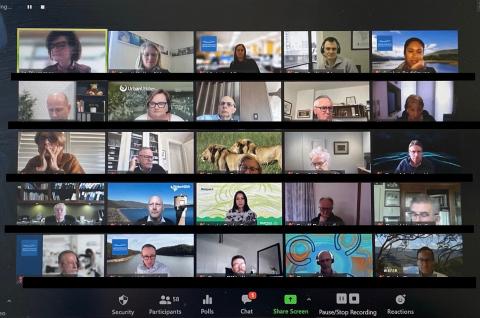Two of our Young Utility Leaders attended the WSAA Chairs and MDs Forum in late August. Sam Rinortner, Hunter Water and Jackson McEwen, Lower Murray Water share their reflections gained from the event.

Sitting nervously in front of the computer screen awaiting the zoom meeting to kick off, the feeling of excitement loomed. Following the click of the mouse, we were suddenly greeted by 50+ industry professionals spanning across Australia and New Zealand, what a surreal experience! Definitely not a typical Tuesday morning!
The meeting was hosted by WSAA’s Executive Director Adam Lovell and aimed to gather feedback from industry leaders on WSAA’s Draft Strategy for 2021-23. Being fortunate enough to be involved in the discussion, as a part of the Young Utility Leaders’ program we eagerly awaited the unfolding of the meeting, hoping to provide some quality input! Being involved in this calibre of discussion was relatively foreign to us. The pace and efficiency of moving through the agenda was evident from the beginning and showed the level of professionalism present.
We began by being presented the three main industry drivers:
- Climate change
- Customer expectations
- Macro industry trends
Being quite relevant to our day-to-day activities in the water industry, it was interesting to compare our thinking as ‘front line’ young utility leaders to that of senior leaders in the industry.
We witnessed Professor of Climate Science, Nerilie Abram deliver an insightful and confronting presentation of the earth’s current climate status. Nerilie’s presentation was a snapshot summary from the 3000-page IPCC report which compressed the findings of over 1400 studies relating to climate change. The brutal truth of climate change already set to raise the earth's atmospheric temperature by 1.5 degrees Celsius, even if corrective measures are undertaken, provided clear justification for immediate action.
If you thought summers were already hot - the current CO2 emissions rate, if continued, would see the earth's temperature rise by a further 4 degrees. This translates to a sharp increase in natural disasters, with droughts becoming more frequent, flash flooding becoming three times as likely to occur and tropical cyclone occurrences increasing by 30%. The most startling aspect following this was the timeframe which we have left to act to avoid the 4-degree hike. Based on current models the increase is set to be a reality within the next seven years. These disasters would obviously have catastrophic effects on the human population, but also closer to home, have a major impact on the supply and security of water in the industry.
We also took in high-level findings from the WSAA National Customer Perceptions Survey, revealing trends around trust, expectations, value for money and purified recycled water for drinking, from across Australia and New Zealand.
Freshly armed with additional knowledge of climate change and customer behaviour, we split up into virtual breakout rooms, each assigned a different topic relating to the draft strategy which was to be discussed. On an individual level, Jackson’s group discussed being more ambitious with goals for carbon neutrality. A personal point of contribution was the importance of communicating the pathway of carbon neutrality across all levels of worker in the water industry including the front-line workers implementing the change. It was great to have the chance to have input and be acknowledged by the broader group.
A very positive and open environment indeed!
Sam’s breakout room discussed opportunities for improvement in regulation and governance. The responses were centred around water literacy, the appetite for risk and the misalignment of roles with other stakeholders. It was pointed out that customers needed to be aware of the fluctuation of prices and the reasoning behind the fluctuation as a way of ensuring transparency.
The group also discussed water businesses expanding into the circular economy. Responses were targeted at highlighting the need to eliminate or minimise the amount of waste coming out of our processes in a bid to create a circular economy, whilst also being conscious of its commercial viability. Other ideas included the possibility of examining all sources of waste recovery, to look for potential utilisation of organic waste to energy plant.
Post discussion, everyone reunited to present their group's three main findings. Amazingly, Chantel and Marz, both Young Utility Leaders, were courageous enough to present their group findings. This again highlighted the inclusive environment, as well as initiative from both young leaders! Each group's presentation added to the ‘pool’ of great ideas which will help mold the final WSAA Strategy.
With Adam completing the final wrap-up of everything just one minute over time, we were left buzzing with ideas on the future of the water industry.
In successfully completing our first high-level discussion with leaders of the industry, it must be said that the pace and flow of ideas was something to behold. Also, the freedom to contribute filled us with excitement and optimism for future group interactions moving forward!
